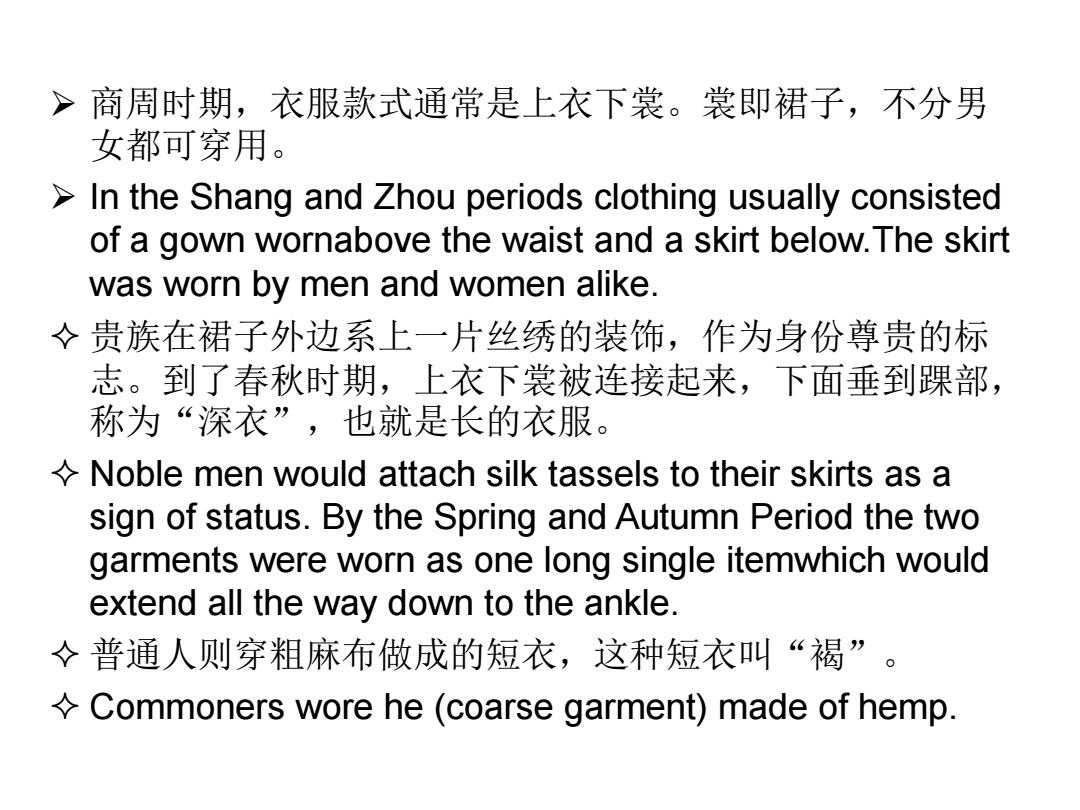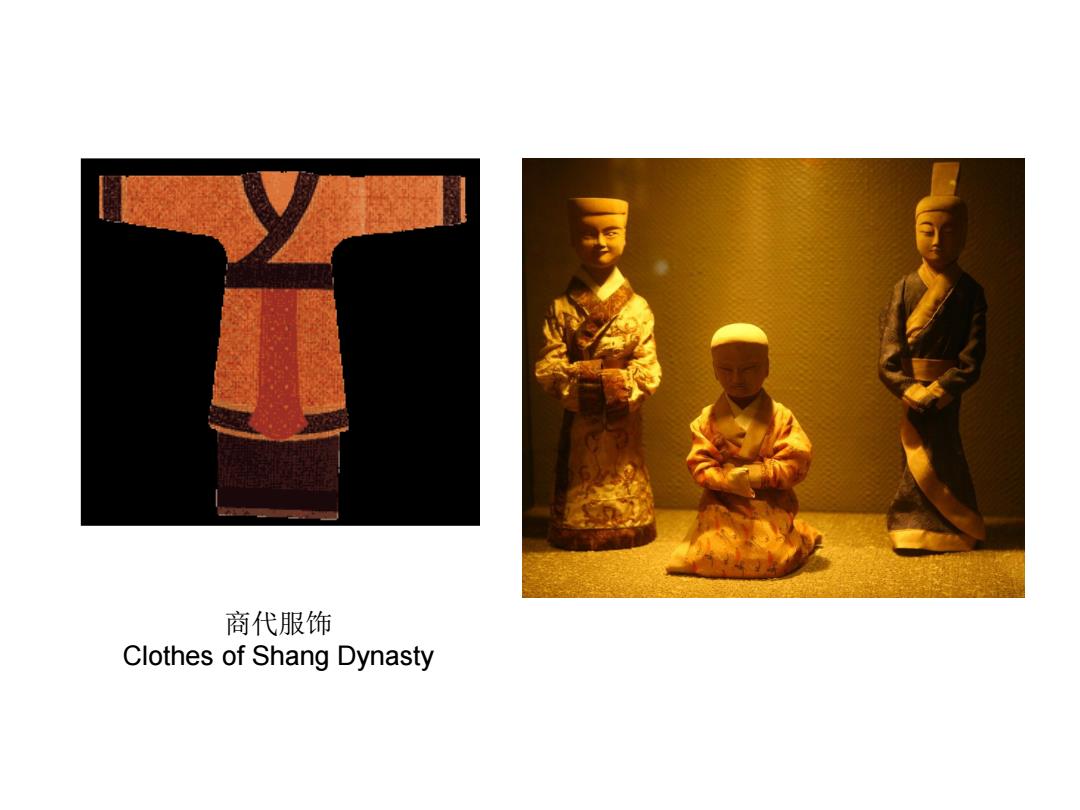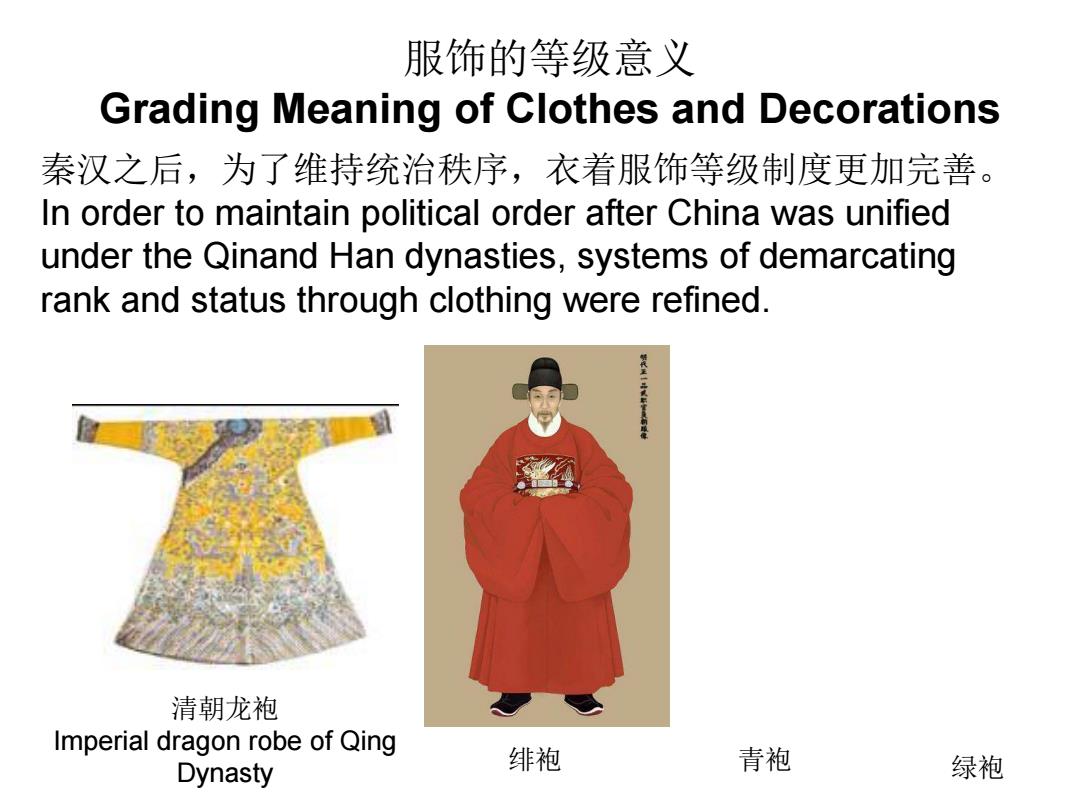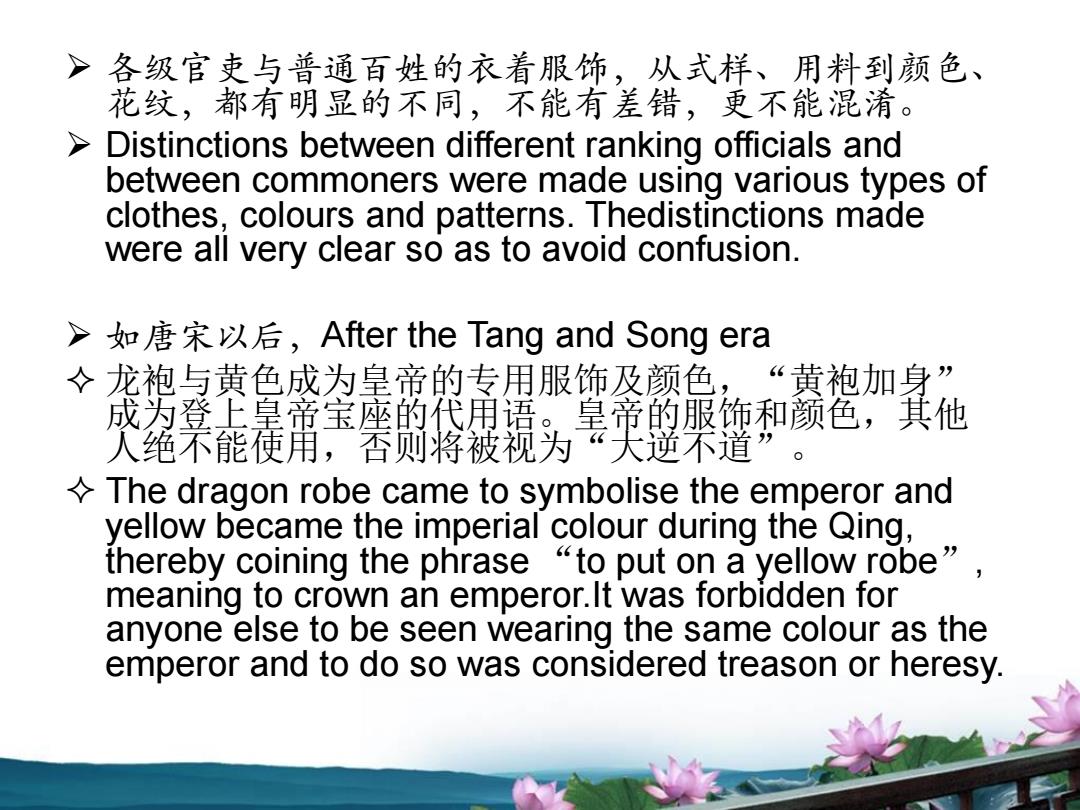
穿衣戴帽有讲究 Dressiness of Clothes and Hats ◇普通平民则不得戴冠,只能戴帻,也就是戴头巾。帻一般是黑 色的,秦朝称百姓为“黔首”,“黔”即黑色,据说是因为老百 姓戴黑头巾。 Common people were forbidden from wearing actual hat and instead adopted a head cloth to cover their hair.The term qianshou (black headed people),coined under the Qin Dynasty for common people stems from the fact that these head cloths were usually black
穿衣戴帽有讲究 Dressiness of Clothes and Hats 普通平民则不得戴冠,只能戴帻,也就是戴头巾。帻一般是黑 色的,秦朝称百姓为“黔首”,“黔”即黑色,据说是因为老百 姓戴黑头巾。 Common people were forbidden from wearing actual hat and instead adopted a head cloth to cover their hair. The term qianshou (black headed people), coined under the Qin Dynasty for common people stems from the fact that these head cloths were usually black

>商周时期,衣服款式通常是上衣下裳。裳即裙子,不分男 女都可穿用。 In the Shang and Zhou periods clothing usually consisted of a gown wornabove the waist and a skirt below.The skirt was worn by men and women alike. ◇贵族在裙子外边系上一片丝绣的装饰,作为身份尊贵的标 志。到了春秋时期,上衣下裳被连接起来,下面垂到踝部, 称为“深衣”,也就是长的衣服。 Noble men would attach silk tassels to their skirts as a sign of status.By the Spring and Autumn Period the two garments were worn as one long single itemwhich would extend all the way down to the ankle. ◇普通人则穿粗麻布做成的短衣,这种短衣叫“褐”。 Commoners wore he(coarse garment)made of hemp
商周时期,衣服款式通常是上衣下裳。裳即裙子,不分男 女都可穿用。 In the Shang and Zhou periods clothing usually consisted of a gown wornabove the waist and a skirt below.The skirt was worn by men and women alike. 贵族在裙子外边系上一片丝绣的装饰,作为身份尊贵的标 志。到了春秋时期,上衣下裳被连接起来,下面垂到踝部, 称为“深衣”,也就是长的衣服。 Noble men would attach silk tassels to their skirts as a sign of status. By the Spring and Autumn Period the two garments were worn as one long single itemwhich would extend all the way down to the ankle. 普通人则穿粗麻布做成的短衣,这种短衣叫“褐”。 Commoners wore he (coarse garment) made of hemp

商代服饰 Clothes of Shang Dynasty
商代服饰 Clothes of Shang Dynasty

服饰的等级意义 Grading Meaning of Clothes and Decorations 秦汉之后,为了维持统治秩序,衣着服饰等级制度更加完善。 In order to maintain political order after China was unified under the Qinand Han dynasties,systems of demarcating rank and status through clothing were refined. 清朝龙袍 Imperial dragon robe of Qing Dynasty 绯袍 青袍 绿袍
服饰的等级意义 Grading Meaning of Clothes and Decorations 清朝龙袍 Imperial dragon robe of Qing Dynasty 绯袍 青袍 绿袍 秦汉之后,为了维持统治秩序,衣着服饰等级制度更加完善。 In order to maintain political order after China was unified under the Qinand Han dynasties, systems of demarcating rank and status through clothing were refined

> 各级官吏与普通百姓的衣着服饰,从式样、用料到颜色、 花纹,都有明显的不同,不能有差错,更不能混淆 >Distinctions between different ranking officials and between commoners were made using various types of clothes,colours and patterns.Thedistinctions made were all very clear so as to avoid confusion. >如唐宋以后,After the Tang and Song era ◇龙袍与黄色成为皇帝的专用服饰及颜色,“黄袍加身” 成为登上皇帝宝座的代用语。.皇帝的服饰和颜色,其他 人绝不能使用,否厕将被视为“大逆不道”。 The dragon robe came to symbolise the emperor and yellow became the imperial colour during the Qing, thereby coining the phrase "to put on a yellow robe" meaning to crown an emperor.It was forbidden for anyone else to be seen wearing the same colour as the emperor and to do so was considered treason or heresy
各级官吏与普通百姓的衣着服饰,从式样、用料到颜色、 花纹,都有明显的不同,不能有差错,更不能混淆。 Distinctions between different ranking officials and between commoners were made using various types of clothes, colours and patterns. Thedistinctions made were all very clear so as to avoid confusion. 如唐宋以后,After the Tang and Song era 龙袍与黄色成为皇帝的专用服饰及颜色,“黄袍加身” 成为登上皇帝宝座的代用语。皇帝的服饰和颜色,其他 人绝不能使用,否则将被视为“大逆不道”。 The dragon robe came to symbolise the emperor and yellow became the imperial colour during the Qing, thereby coining the phrase “to put on a yellow robe” , meaning to crown an emperor.It was forbidden for anyone else to be seen wearing the same colour as the emperor and to do so was considered treason or heresy